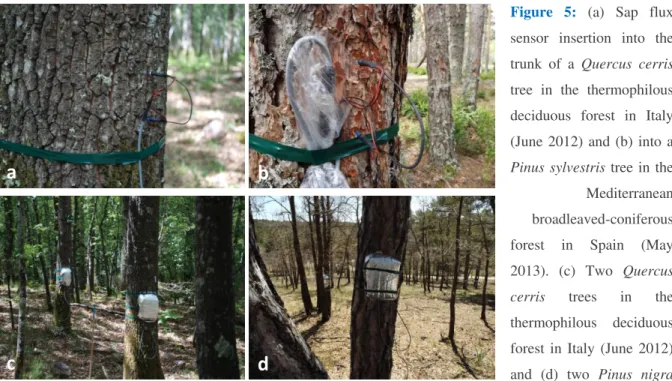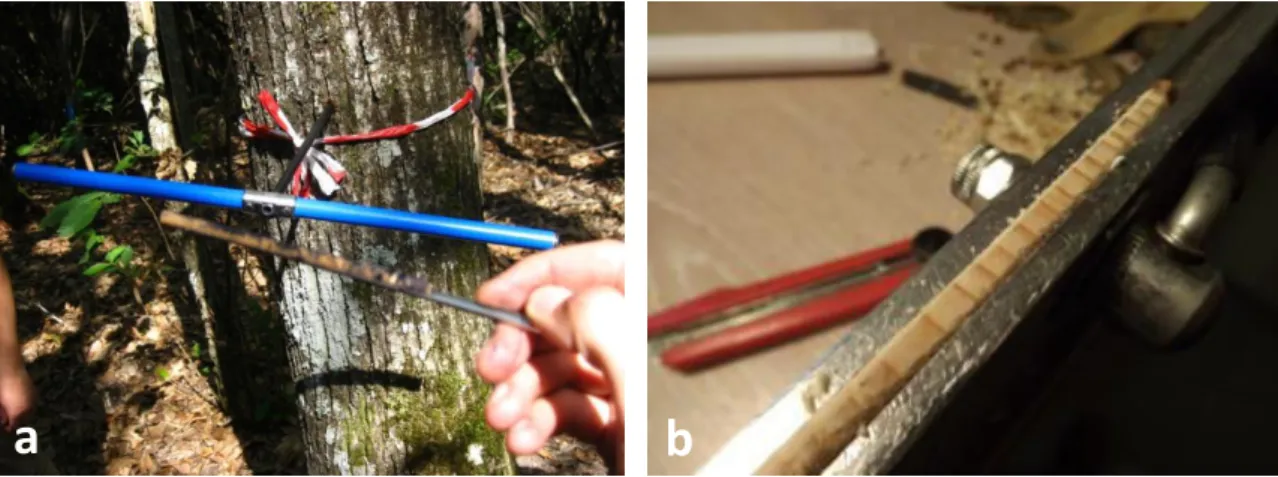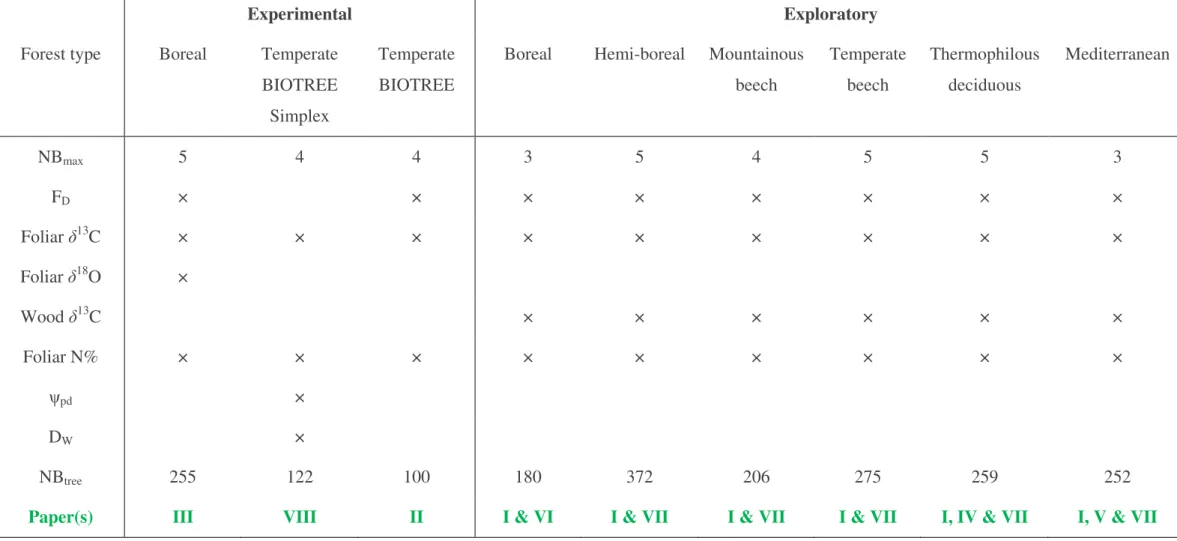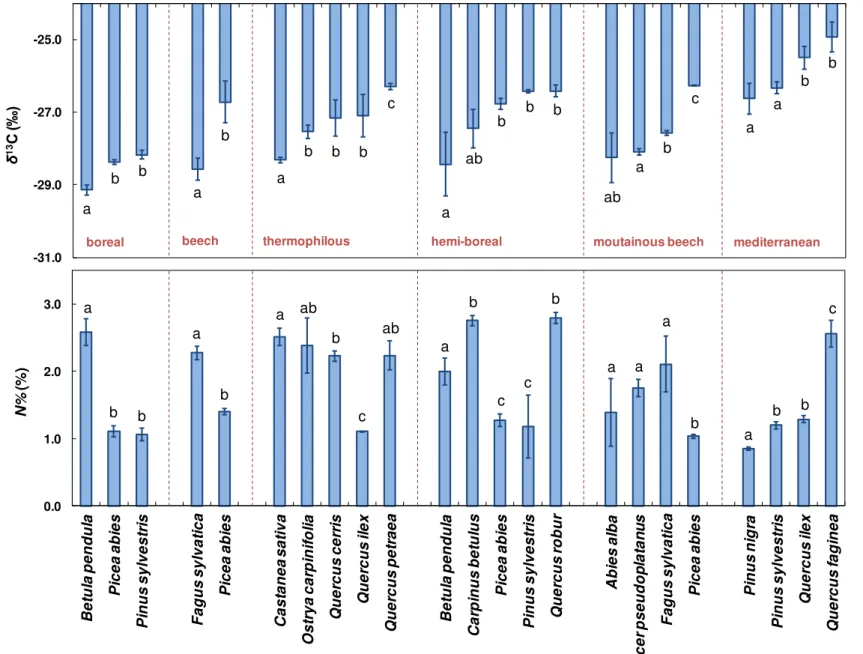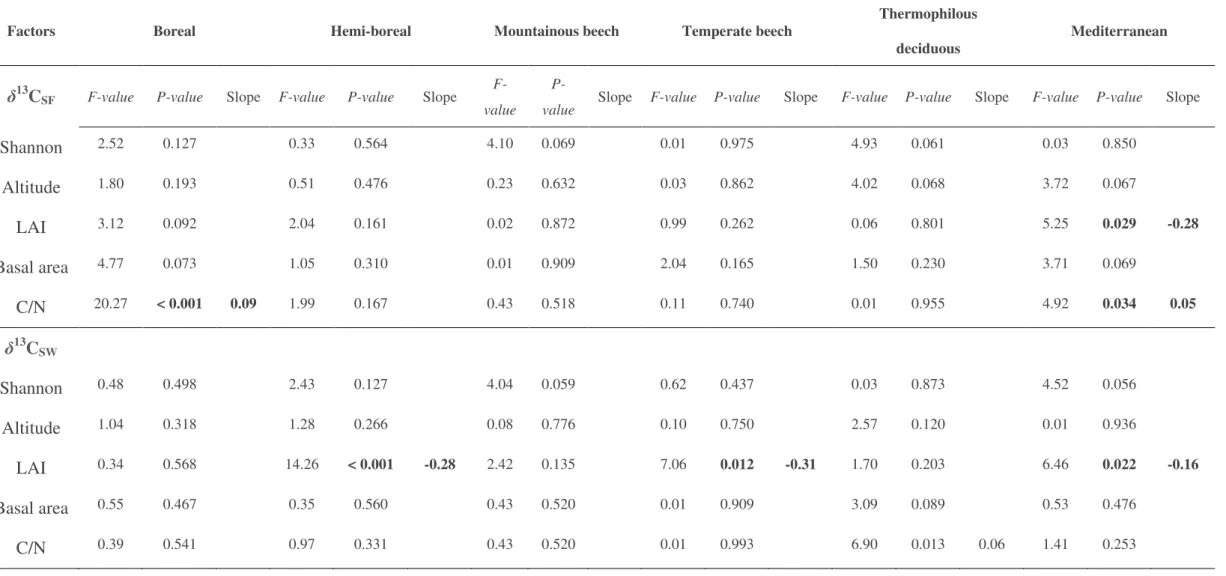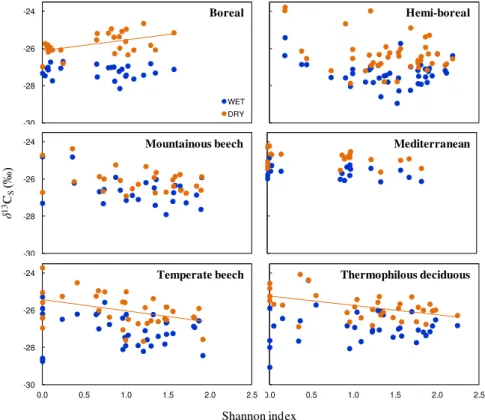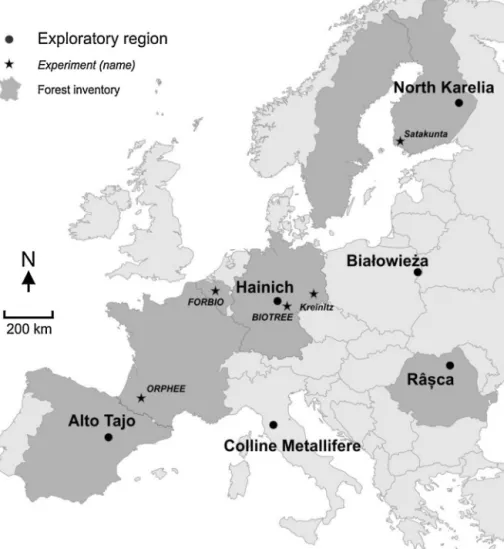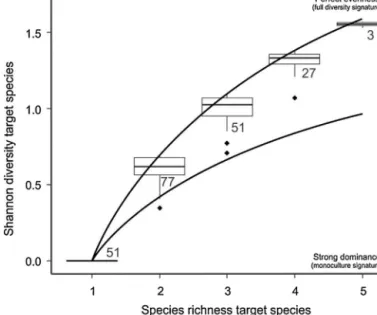HAL Id: tel-02793207
https://hal.univ-lorraine.fr/tel-02793207v2
Submitted on 29 Mar 2018
HAL is a multi-disciplinary open access
archive for the deposit and dissemination of
sci-entific research documents, whether they are
pub-lished or not. The documents may come from
teaching and research institutions in France or
abroad, or from public or private research centers.
L’archive ouverte pluridisciplinaire HAL, est
destinée au dépôt et à la diffusion de documents
scientifiques de niveau recherche, publiés ou non,
émanant des établissements d’enseignement et de
recherche français ou étrangers, des laboratoires
publics ou privés.
relations in European forests
Charlotte Grossiord
To cite this version:
Charlotte Grossiord. Impact of tree species diversity on water and carbon relations in European
forests. Silviculture, forestry. Université de Lorraine, 2014. English. �NNT : 2014LORR0155�.
�tel-02793207v2�
AVERTISSEMENT
Ce document est le fruit d'un long travail approuvé par le jury de
soutenance et mis à disposition de l'ensemble de la
communauté universitaire élargie.
Il est soumis à la propriété intellectuelle de l'auteur. Ceci
implique une obligation de citation et de référencement lors de
l’utilisation de ce document.
D'autre part, toute contrefaçon, plagiat, reproduction illicite
encourt une poursuite pénale.
Contact : ddoc-theses-contact@univ-lorraine.fr
LIENS
Code de la Propriété Intellectuelle. articles L 122. 4
Code de la Propriété Intellectuelle. articles L 335.2- L 335.10
http://www.cfcopies.com/V2/leg/leg_droi.php
1
Submitted to obtain the title of
Doctor of the University of Lorraine,
in Forest Biology
by Charlotte Grossiord
Impact of tree species diversity on water and
carbon relations in European forests
Jury members:
Dr. Rolf Siegwolf
Paul Scherrer Institute (Switzerland)
Dr. Prof. Richard Michalet University of Bordeaux I (France)
Dr. David Forrester
Albert-Ludwigs-Universität Freiburg (Germany)
Dr. Tobias Gebauer
University of Hamburg (Germany)
Dr. Prof. Bernard Amiaud University of Lorraine (France)
Dr. Damien Bonal
INRA Nancy (France)
3
and water relations in European forests
To manage a system effectively, you might focus on the interactions of the parts rather than
their behavior taken separately
5
Acknowledgments
I would like to start by thanking the two major contributors to this work, my two supervisors,
Dr Damien Bonal and Dr Arthur Gessler. I am extremely grateful for the great opportunity
they gave me by selecting me for this PhD and thereby allowing me to discover the
fascinating and often challenging field of ecophysiological science. I consider them both to be
my mentors as I enjoyed and learnt a great deal from the time that we have worked together. I
would specifically like to thank Damien with whom I interacted the most during these three
years. His implication, perspicacity, great ideas, constructive criticism and council make him
one of the major actors in the success of this work and I am extremely grateful.
Someone I would also particularly like to express my gratitude to is André Granier. Although
he was not officially one of my supervisors, I still consider him as such. Thank you for
sharing with me all the secrets of the “Granier method”. I will never forget your wonderful
support in the field (particularly in Romania!) but also throughout the long periods of
reflection necessitated by this work.
This research involved considerable field work all over Europe and I would therefore like to
thank all the people that contributed to this huge part of the work. Sampling leaves at the top
of more than 1500 trees would not have been possible without the help of the “Leaf Team”
from the FunDiv EUROPE project. Therefore, I would like to express my gratitude to
Virginie Guyot, Eleftheria Dalmaris, Martina Pollastrini, Diem Nguyen, Vera Holland and
Filippo Bussotti. If my calculations are correct, we traveled more than 23,000 km together and
all spend endless hours in airports and planes over the last three years. We still managed to
keep an extraordinary team spirit and have many good times.
After the “Leaf Team”, I would like to thank the “Core Team” (Adam Benneter, Tommaso
Jucker, Gabriel Duduman, Daniel Avacaritei, Ionut Barnoaiea, Iulian Dănilă) with whom I
sampled wood cores in Germany and who sampled all the cores from the Spanish, Polish and
Romanian sites for me. Thank you very much for everything; without your help I would
probably still be coring trees in the Carpathian mountains.
Next I would like to thank all the scientists (Sandra Mueller, Alicia Forner, Andrea Coppi,
Matteo Feducci, Andreas Peuke, Dietmar Lüttschwager, Olivier Bouriaud, Fernando
Valladares, Robert Hommel, Rainer Hentschel), technicians (Sigrid Berger, Felix Berthold,
Miguel Fernández, David L. Quiroga, Arto Saari, Raino Lievonen, Dawid Zielinski and
Johannes Bruckhoff), tree climbers (Ciencia, Claudio, Giovanni, Franscesco, Robert, Marcin,
6
Paweł, Peter, Bennet, Jessica, Carsten, Holger, Andre and Henrick) and local firemen from
the city of BadSalzungen. Thank you for helping me carrying and install the heavy material
needed for sap flux measurements, for sampling leaves at the tops of trees, change the
batteries in the field and providing water for the labelling experiment. I even have a soft spot
in my heart for the Romanian horse that carried the heavy material needed to take sap flux
measurements.
I am also grateful to Prof. Dr. Michael Scherrer-Lorenzen who initiated this great project, was
part of my PhD committee and has always been available for pertinent advice.
I would like to thank François Geremia for his cheerfulness and for teaching me all the secrets
of wood coring and tree ring analyses.
I also wish to thank Claude Brechet and Christian Hossman for their involvement, particularly
for the huge number of analyses they conducted for me on the mass spectrometers.
This work also involved important administrative procedures. I would therefore like to thank
Rosine Gross, Laurence Le Maout, Audrey Chardin and Adeline Vuillaume for their support
and their help.
Special thanks goes to Cecilia Gana, my office partner, and our two neighbors Erwin Dallé
(alias Van Damme) and Nicolas “Braun”, for their support and necessary distractions during
lunch breaks.
I would like to thank all my colleagues from the EEF unit who where always ready to give
advice on the scientific aspects of this work among other things. I am deeply grateful for
having had the opportunity to work within such a cooperative and wonderful research group
as the EEF unit.
My deepest regards go to my parents, Doris and André, for the education they provided me
with, for their constant patience and for giving me their travel bug, which was certainly
needed during these three years. They have always encouraged me in everything I undertake,
particularly concerning my studies.
En groussen Merci un den Hugo Jaeger mat wem ech main Liewen deelen an deen während
deser ganzer Aarbecht eng präsenz wär, souwuel psychesch an physesch, z. B. an Polen wou
hien eng wonnerbar Aarbechtskapaciteit bewisen huet…Merci fir alles!
Finally, I would like to thank all my dear friends and relatives who, even though they did not
directly contribute to this work, were always generous with their support.
Table of content
8
Table of content
List of Publications ... 11
1. General Introduction ... 15
2. Overview of the Material & Methods ... 21
2.1 Study sites... 21
2.2 Sap flux measurements ... 23
2.3 Foliar analyses ... 25
2.4 Wood analyses ... 26
3. Discussion ... 31
3.1 Functional diversity in water and carbon relations in European forests ... 31
3.2 Effects of tree species diversity on water and carbon relations under non-limiting soil water
conditions ... 37
3.2.1 Effects at the tree-level ... 37
3.2.2 Effects at the stand-level ... 40
3.3 Effects of tree species diversity on water and carbon relations under limiting soil water
conditions ... 43
3.3.1 Effects at tree-level ... 43
3.3.1.1 Transpiration ... 43
3.3.1.2 Drought exposure levels ... 44
3.3.2 Effects at stand-level ... 47
4. Conclusions ... 53
5. References ... 55
6. Supplementary Information ... 65
11
List of Publications
This thesis is based on the work contained in the following papers, referred to by Roman
numerals in the text:
I.
Baeten L., K. Verheyen, C. Wirth, H. Bruelheide, F. Bussotti, L. Finér, B.
Jaroszewicz, F. Selvi, F. Valladares, E. Allan, E. Ampoorter, H. Auge, D. Avăcăriei, L.
Barbaro, I. Bărnoaiea, C.C. Bastias, J. Bauhus, C. Beinhoff, R. Benavides, A. Benneter, S.
Berger, F. Berthold, J. Boberg, D. Bonal, W. Brüggemann, M. Carnol, B. Castagneyrol, Y.
Charbonnier, E. Chećko, D. Coomes, A. Coppi, E. Dalmaris, G. Dănilă, S.M. Dawud, de
Vries W., De Wandeler H., Deconchat M., Domisch T., Duduman G., Fischer M., Fotelli M.,
Gessler A., Gimeno T.E., Granier A., Grossiord C., Guyot V., Hantsch L., Hättenschwiler S.,
Hector A., Hermy M., Holland V., Jactel H., Joly F.-X., Jucker T., Kolb S., Koricheva J.,
Lexer M.J., Liebergesell M., Milligan H., Müller S., Muys B., Nguyen D., Nichiforel L.,
Pollastrini M., Proulx R., Rabasa S., Radoglou K., Ratcliffe S., Raulund-Rasmussen K.,
Seiferling I., Stenlid J., Vesterdal L., von Wilpert K., Zavala M.A., Zielinski D. &
Scherer-Lorenzen M. 2013. A novel comparative research platform designed to determine the
functional significance of tree species diversity in European forests. Perspectives in Plant
Ecology, Evolution and Systematics
15, 281-291.
II.
Grossiord, C., A. Granier, A. Gessler, M. Scherer-Lorenzen, M. Pollastrini, & D.
Bonal. 2013. Application of Loreau & Hector's (2001) partitioning method to complex
functional traits. Methods in Ecology and Evolution 4, 954
–960
III.
Grossiord, C., A. Granier, A. Gessler, M. Pollastrini, & D. Bonal. 2013. The
influence of tree species mixture on ecosystem-level carbon accumulation and water use in a
mixed boreal plantation. Forest Ecology and Management 298, 82-92
IV.
Grossiord, C., A. Granier, A. Gessler, F. Bussotti, M. Pollastrini, & D. Bonal. 2014 -
Interspecific competition influences the response of oak transpiration to increasing drought
stress in a mixed Mediterranean forest. Forest Ecology and Management 318, 54-61.
V.
Grossiord, C., A. Forner, A. Gessler, A. Granier, M. Pollastrini, F. Valladares, D.
Bonal. 2014. Influence of species interactions on transpiration of Mediterranean tree species
during a summer drought. European Journal of Forest Research, DOI:
10.1007/s10342-014-0857-8.
VI.
Grossiord, C., A. Granier, A. Gessler, T. Jucker & D. Bonal. 2014. Does Drought
Influence the Relationship between Biodiversity and Ecosystem Functioning in Boreal
Forests? Ecosystems 17, 394-404.
List of publications
12
VII.
Grossiord, C.
, A. Granier, S. Ratcliffe, O. Bouriaud, H. Bruelheide, E. Chećko, L.
Finér, M. Pollastrini, M. Scherer-Lorenzen, F. Valladares, D. Bonal, A. Gessler. 2014. Higher
tree diversity reduces the effect of drought in European forest ecosystems. PNAS, 111,
14812
–14815.
VIII.
Grossiord, C., S. Berger, C. Bréchet, A. Gessler, A. Granier, R. Henschel, R.
Hommel, M. Scherer-Lorenzen, D. Bonal. 2014. Impact of interspecific competition on the
depth of soil water extraction in a young temperate mixed plantation. Journal of Hydrology,
in press.
15
1. General Introduction
Forests cover 31% of the world’s land area and 40 % of Europe’s and include a great diversity
of biotic and abiotic conditions across regions (FAO, 2010; EC, 2013). These ecosystems are
considered multifunctional because they host habitats for animals and plants, they play a
major role in mitigating climate change, and they offer us many benefits such as clean
freshwater, improved health, and recreation and touristic opportunities. However, in order for
forests to deliver these functions and services in a balanced way, it is essential to ensure a
sustainable management of these ecosystems. During the last decades, forests policies in
Europe have largely evolved in this direction and management objectives no longer favor
wood production only, be it oriented toward quantity or quality (EC, 2013). To protect forests
from the significant effects of storms, fires, scarce water resources and pests, forest
management strategies also aim to maintain natural forest dynamics and to favor the
conservation of species diversity. A conversion from pure- to mixed-species stands has
already been put into practice by forest administrations and has led to an overall increase in
the proportion of mixed species forests in Europe (Knoke et al. 2008).
The general interest in the relationship between species diversity and ecosystem functions and
services originally rose from the important loss of biodiversity occurring in most natural
ecosystems world-wide (MEA 2005). More than 30 years of ecological studies have led to a
consensus that ecosystem performance is highly dependent on species richness and/or
functional diversity (Loreau et al. 2001; Hooper et al. 2005). Until recently, most of the
research carried out on this subject concerned simple communities like grasslands (e.g.
Tilman & Downing 1994; Hector et al. 2010). The ability to experimentally manipulate
species in these ecosystems and the reasonable timeframe in which results are available
explain
ecological researchers’ enthusiasm for studies in these ecosystems (Scherer-Lorenzen
et al 2007; Hector et al. 2010). Woody species, however, were largely excluded from these
early experiments, despite the ecological and socioeconomic importance of forest ecosystems.
Nevertheless, over the last 15 years, a body of evidence demonstrating the benefits provided
by higher tree species diversity in forest ecosystems has started to accumulate as well. Greater
tree species diversity has been found to be related to improvement in some vital forest
ecosystem functions such as wood production (e.g. Zhang et al. 2012), efficiency of nutrient
use (e.g. Menalled et al. 1998) and resistance to insect pests or diseases (e.g. Jactel &
Brockerhoff 2007).
Introduction
16
Several mechanisms have been put forward in the literature to explain how species
composition and functional diversity can influence ecosystem functions and services. For
example, higher species diversity can have a negative influence resulting in lower ecosystem
performance driven by direct competition for the available resources among co-existing
species. These “negative” interactions commonly arise when ecological niches overlap and
neighboring species with the same functional characteristics are functionally redundant in the
ecosystem (Vila & Sardans 1999). In contrast, higher species diversity can also result in
improved ecosystem performance; here, two distinct mechanisms are commonly involved:
complementarity and selection. Firstly, the complementary acquisition and use of resources
among species includes both ecological niche partitioning, where species coexist without
major interspecific competition for resources, and facilitation processes whereby the presence
of a given species will be beneficial for the functioning of a neighboring species (Loreau &
Hector 2001). Secondly, the selection effect states that a highly-performing species, i.e. one
leading to improved ecosystem functioning, is more likely to occur in ecosystems with high
species diversity (Loreau & Hector 2001). Complementarity and selection mechanisms are
not mutually exclusive; both can simultaneously affect ecosystem functions. Therefore,
separately quantifying complementarity and selection effects is important to understand what
underlying mechanisms are driving tree species diversity effects. In 2001, Loreau & Hector
proposed a convenient method to partition the net biodiversity effect observed on
ecosystem-level productivity into complementarity and selection effects. However, the application of this
method has so far been limited to the study of only a few ecosystem functions because many
ecological properties such as respiration, photosynthesis or the efficiency to acquire and use
resources, are not additive as is productivity, and therefore cannot be calculated at the
ecosystem level in the same way.
In addition to competition and the complementarity and selection processes, local
environmental conditions are also known to play a role in species diversity effects on
ecosystem functions and services (Hooper & Dukes 2004; Belote et al. 2011). Indeed, the
interactions between any given pair of species are dynamic, changing as resource availability
or climatic conditions change. It is not unusual for “positive” interactions that enhance
ecosystem functioning to tu
rn into “negative” interactions under new conditions, thereby
reducing ecosystem performance. The reverse is also true. Under the assumptions of the
‘‘stress gradient’’ hypothesis, which predicts that the net outcome of biotic interactions shifts
from negative to positive along gradients of limiting abiotic conditions (Bertness & Callaway
17
1994), beneficial species diversity effects are expected to be more common under severely
resource-limited conditions. This conceptual framework is of great interest because it suggests
that the relationships between species diversity and ecosystem functioning that exist today are
likely to change in the future with the more intense and severe drought episodes forecasted by
climate models (
Figure 1
). A large body of evidence supporting such a shift in the outcome
of species interactions under more stressful environmental conditions has already been
accumulated for marine, freshwater and terrestrial habitats (He et al. 2013; Herbert et al.
2004; Jucker & Coomes 2012; Steudel et al. 2012; Wang et al. 2013). However, observations
which do not support the predictions of the “stress-gradient” hypothesis have also been found
(e.g. Maestre & Cortina 2004; Maestre et al. 2005; Tielbörger & Kadmon 2000). This
indicates that the exact role of environmental conditions in the relationship between species
interactions and ecosystem functioning remains unclear.
Figure
1:
Increased
frequency of drought by
the end of the century in
Europe. Projected changes
in the 95th percentile of the
length of dry spells (days)
for 2071–2100 compared to
1971
–2000. Mean of 20
regional
EUROCODEX
climate models (extracted
from Jacob et al. 2014).
The expected increase in the frequency and severity of drought episodes (IPCC 2013,
Figure
1
) is one of the main changes in climatic conditions which could severely affect species
interactions and consequently, ecosystem functioning in mixed habitats. The combined effects
of changing temperatures and precipitation patterns will modify evaporative demand, gas
exchange, carbon allocation, nutrient mineralization, and the growth and survival of plants in
terrestrial ecosystems, among them forests (Saxe et al. 2000; Bréda et al. 2006; Rennenberg et
al. 2006; McDowell et al. 2008). Tree species have a wide range of water use strategies in
Introduction
18
order to cope with very dry environmental conditions involving leaf- or plant-level structural
and/or physiological adaptations (e.g. Kramer 1983). These different strategies have been
widely studied, but much less is known about how the interactions among species with similar
(or contrasting) water-use strategies during drought stress will affect their physiological
responses to water depletion in forest ecosystems. In recent years, some evidence of the
influence of tree species composition and richness on functions related to the water and
carbon cycle has been found. For example, in dry-climate mixed forests, combinations of
species with different functional traits and/or higher tree species richness have been shown to
improve water use and influence water use efficiency (Forrester et al. 2010; Kunert et al.
2012). In a temperate wet-climate forests on the other hand, tree species richness itself was
shown to have no direct impact on water use rates (Gebauer et al. 2012; Moore et al. 2011).
These few case studies do not allow us to generalize these effects, but at least they have
demonstrated the important influence of local climatic conditions on how tree species
diversity affects the water and carbon cycle. Complementary studies are necessary to allow us
to predict how tree species diversity will influence the response of forest ecosystems to drier
climatic conditions and to prepare climate-smart management practices for the future.
The overall aim of this thesis was to analyze the role of tree species diversity on forest
ecosystem functions related to the water and carbon cycle at both tree and stand-level under
contrasted environmental conditions. The study area was located along a North-South
grad
ient in Europe and includes Europe’s main forest types and climatic conditions. Field
measurements of tree transpiration, estimation of the depth of water uptake by trees and
measurements of carbon isotope composition (a proxy for carbon and water trade-off) in
foliar and woody material were conducted in forested sites including both young tree
plantations and adult forest stands. The work was done within the framework of the European
project “FunDivEUROPE” (FP7/2007-2013).
This thesis presents three years of work through a global overview and eight original papers
(published or submitted). The different parts of this document complement each other
although certain repetitions could not be avoided. A brief description of the material and
methods is given before the main discussion. More detailed information on the experimental
designs can be found in each related paper.
19
The specific aims of the different papers were to:
1. Present the design and implementation of the FunDivEUROPE exploratory platform
consisting of forest stands along tree species diversity gradients in six major European
forest types (
Paper I
). Note here that my personal contribution to this paper was only
minor. However, the paper is referred to in this overview since it explains the
experimental approach and design used for this work.
2. Adapt the original method proposed by Loreau & Hector (2001) in order to apply it to
complex functional traits like stand-level water use efficiency (
Paper II
).
3. Determine the impact of tree species diversity on tree- and stand-level transpiration,
water use efficiency and carbon accumulation under favorable soil water conditions
(
Paper III
).
4. Determine the impact of tree species diversity on tree-level transpiration under dry soil
conditions (
Papers IV & V
).
5. Compare the impact of tree species diversity on stand-level drought exposure across
the main European forest types (
Papers VI &
VII
).
6. Determine whether below-ground stratification in the depth of soil water uptake and a
potential resulting complementarity for water use occurs in temperate mixed-species
forests (
Paper VIII
).
21
2. Overview of the Material & Methods
2.1 Study sites
One major aim of the “FunDivEUROPE” project was to show the need for and subsequently
implement a new generation of research that brings functional biodiversity research into the
complex realm of the forest and examines ecosystem processes that provide important goods
and services to humanity. More specifically, the scientists working within the framework of
the “FunDivEUROPE” project are trying to quantify the effects of forest tree species diversity
on ecosystem functions and services in major European forest types (www.fundiveurope.eu).
To do so, two research platforms were established in order to include both experimental and
observational approaches. This thesis includes studies conducted in both platforms (
Figure 2
).
Figure
2:
Geographical
distribution of the study sites
included
either
in
the
experimental
platform
(plantations)
or
in
the
exploratory platform (adult
forests) of the FunDivEUROPE
project. The experimental sites
are the boreal plantation in
Satakunta (Finland) and the
BIOTREE temperate plantation
(Germany). Going from North
to South, the exploratory sites
are a boreal forest (Finland), a
hemi-boreal forest (Poland), a
temperate
beech
forest
(Germany),
a
mountainous
temperate beech forest (Romania), a thermophilous deciduous forest (Italy) and a Mediterranean
broadleaved-coniferous forest (Spain). The colored background in the figure shows the distribution of the European forest
categories (extracted from Casalegno et al. 2011).
Boreal Hemi-boreal Alpine coniferous Acidophylous oakwood Mesophytic deciduous Mountainous beech Thermophilous deciduous Broadleaved evergreen Coniferous Mediterranean Beech Forest categories Exploratory sites Experimental sites
Overview of the Material & Methods
22
The experimental platform relies on tree diversity experiments conducted within the
TreeDiv_Net network, where tree plantations differing in tree species diversity were
established since 1999. The present work was conducted at only two experimental sites in the
experimental platform: a mixed boreal plantation in Satakunta (Finland) and the BIOTREE
and BIOTREE-simplex mixed temperate plantations in Kaltenborn (Germany) (
Figures 2 &
3
). More information on these sites can be found in
Papers II
,
III
&
VIII
.
Figure 3:
Pictures of the experimental sites: (a) the mixed boreal plantation in Satakunta (Finland), (b) the
BIOTREE-simplex temperate mixed plantation and (c) the BIOTREE temperate mixed plantation, both in
Kaltenborn (Germany).
The exploratory platform consists of a specifically designed network of approximately 300
stands in mature forests in six different focal regions in Europe, replicated across wide
gradients of tree species diversity. The six focal regions represent important European forest
types along the gradient from boreal forests to Mediterranean forests (
Figures 2 & 4
). This
approach maximizes representativeness at the continental scale. Within each focal region, the
forest stands primarily differ in tree species richness (natural or management driven).
Variations in other factors such as soil type, topography, land use history and spatial
clustering, which may profoundly influence functions and services, were kept at a minimum.
Some variability in these factors could not be avoided however, and they were therefore
included in the statistical analyses as confounding factors. A detailed description of the
exploratory platform can be found in
Paper I
while less detailed descriptions are presented in
Papers IV
,
V
,
VI
,
&
VII
.
23
Figure 4:
Pictures of the exploratory sites: (a) boreal forest in Finland, (b) hemi-boreal forest in Poland, (c)
mountainous beech forest in Romania, (d) temperate beech forest in Germany, (e) thermophilous deciduous
forest in Italy and (f) Mediterranean broadleaved-coniferous forest in Spain.
2.2 Sap flux measurements
At all sites included in the exploratory platform as well as in the experimental “Satakunta”
and BIOTREE sites, we used the thermal dissipation method to measure sap flux density. In
the Satakunta plantation, this work was conducted by A. Granier, D. Bonal and L. Bes De
Berc during the summer of 2011 and data were made available for my PhD. At the other sites,
the work was conducted by myself and A. Granier, with the help of D. Bonal at some sites,
and the occasional help of students, local technicians, or other scientists. Depending on the
study site, a subsample of dominant and/or co-dominant trees, for a given species and in a
given number of forest stands was equipped with sap flux sensors. For each selected tree, the
two 20-mm-long probes of the thermal dissipation sap flux sensors (UP-Gmbh, Cottbus, GE)
(Granier et al. 1987) were installed under the bark and the cambium at around 1.3 m above the
ground with a 10-cm vertical spacing between the probes (
Figure 5
).
a
b
c
Overview of the Material & Methods
24
Figure 5:
(a) Sap flux
sensor insertion into the
trunk of a Quercus cerris
tree in the thermophilous
deciduous forest in Italy
(June 2012) and (b) into a
Pinus sylvestris
tree in the
Mediterranean
broadleaved-coniferous
forest in Spain (May
2013). (c) Two Quercus
cerris
trees
in
the
thermophilous deciduous
forest in Italy (June 2012)
and (d) two Pinus nigra
trees in the Mediterranean broadleaved-coniferous forest in Spain (May 2013) equipped with sap flux sensors
after the covers had been put in place.
Each sensor was supplied with a power of 0.2 W. Data were collected every five or ten
seconds on CR800 and/or CR1000 data loggers (Campbell Scientific Inc, Loughborough, UK)
for periods ranging from two to five days. These measurement periods were repeated over
several months at some sites, when technical issues (power supply, for instance) could be
easily solved. Volumetric sap flux density (F
D, L dm
-2h
-1) was calculated following Granier
(1987). Daily tree-level transpiration values based on F
Dwhere converted into stand-level
transpiration rates; however, because of the limited number of stands studied, no statistical
analyses could be conducted on stand-level data. More information on the experimental
design for the “Satakunta” site (Finland), the thermophilous deciduous (Italy) and
Mediterranean broadleaved-coniferous forest sites (hereafter called Mediterranean, Spain) can
be found in
Papers III
,
IV
&
V
, respectively. At the other study sites, a protocol similar to
the one at the Italian site was applied (
Paper IV
). However, as the data obtained at these other
sites were not sufficiently reliable, these results are not presented in this overview and nor are
they referred to in any paper.
a
b
25
2.3 Foliar analyses
At all exploratory sites and in the experimental “Satakunta” and BIOTREE-simplex sites, the
FundivEUROPE “Leaf Team” and I sampled ten to twenty fully expanded sunlit leaves for
broadleaved species, or three to five 30-to-40-cm-long branches supporting fully mature
needles for conifers, during the 2012 or 2013 summers on a subsample of dominant and/or
co-dominant trees in each selected stand. All samples were collected during summers when no
water stress occurred or before water stress had started (i.e. thermophilous deciduous and
Mediterranean forests). Leaf samples were collected with tree clippers connected to extension
loppers, by shooting down branches (Romania only), or by professional tree climbers who
were hired to work on the project (
Figure 6
).
We used isotopic ratio mass spectrometers (IRMS) to measure the carbon isotope composition
(
δ
13C, ‰) and nitrogen contents (N%, %) on these foliar samples, and in addition, at the
Satakunta site in Finland, the oxygen isotope composition (
δ
18O, ‰). Sample preparation
(grinding, micro-weighing) was conducted by myself with the occasional help of local
technicians at INRA Nancy. Isotopic analyses were done either at the PTEF Isotope Facility
of INRA Nancy or at the Isotope Facility of UC Davis (CA, USA).
δ
13C is positively related to leaf intrinsic water use efficiency (Farquhar et al. 1982), which is
defined as the ratio of net CO
2assimilation over stomatal conductance to water vapour.
Therefore
δ
13C provides information on intrinsic water use efficiency (WUE
int) integrated
over various time periods depending on the turnover time of the organic matter pools assessed
(Fotelli et al. 2003). However, the
δ
13C of organic matter is influenced by a large range of
environmental factors including light intensity, atmospheric CO
2concentrations or water
availability (reviewed in Ferrio et al. 2003b). To avoid effects related to gradients of light and
CO
2concentrations within forest canopies, we only sampled sunlit leaves or needles at the
Overview of the Material & Methods
26
Figure 6:
(a) Sampling of
canopy leaves with tree
clippers
connected
to
extension loppers in the
Mediterranean forest in
Spain (June 2013) and (b)
sampling
of
canopy
leaves by a tree climber in
the
thermophilous
deciduous forest in Italy
(June 2012).
The combined measurement of
δ
18O and
δ
13C provides further insight into the changes in leaf
δ
13C (Farquhar et al. 1998; Saurer et al. 1997). Indeed, variations in
δ
18O are mainly driven by
source water and changes in stomatal conductance (Farquhar et al. 1998). Measuring both
δ
18O and
δ
13C allowed us to distinguish between the stomatal and the photosynthetic origin of
the changes in
δ
13C (
Paper III
).
At the BIOTREE-simplex site, we used two Scholander-type pressure chambers (PMS
Instruments, Corvallis, USA and UP Analytics, Cottbus, Germany) to measure predawn leaf
water potential on the sampled leaves or twigs of the studied species. More information on
specific measurements conducted for each site on the leaf samples can be found in
Papers II
,
III
,
IV
,
V
&
VIII
.
2.4 Wood analyses
At all the exploratory sites and with the help of
the FunDivEUROPE “Core Team”, I
extracted one 5-mm-diameter wood core at breast height (1.3 m) on a subsample of dominant
and/or co-dominant trees for each species and in each forest stand (
Figure 7
).
27
Figure 7:
(a) Extraction of a wood core from a Castanea sativa tree in the thermophilous deciduous forest in
Italy and (b) the wood core from a Pinus sylvestris tree from the boreal forest in Finland after being filed with a
scalpel for tree-ring dating.
For each site, A. Granier and I selected two years with contrasting soil water limitations
during the summer (dry vs. wet year) based on local climatic date and a water balance
modeling approach (BILJOU model, Granier et al. 1999). Daily meteorological data for each
forest study site were obtained from the CGMS database of interpolated meteorological data
(AGRI4CAST, http://mars.jrc.ec.europa.eu/mars). Then, from each wood core, I extracted the
late-wood corresponding to the two selected years for each site and prepared the samples for
isotope analysis. The samples from a given species within a given stand were pooled together
before isotope analysis. Samples from Quercus ilex in the Mediterranean forest were not
analyzed for isotope composition as there was insufficient material in the late wood for the
isotope analyses, particularly for the dry year. Furthermore, tree-ring detection was very
difficult for this species.
δ
13C values were measured at the Isotope Facility of PTEF (INRA
Nancy) or UC Davis (CA, USA). More information on sample preparations and year selection
for each site can be found in
Papers VI
&
VII.
Plants typically react to a decrease in water availability by closing their stomata. Although
carboxylation rates may also decline under water shortage, leaf conductance is usually
affected to a larger extent, and this leads to a reduction in intercellular CO
2concentrations and
a concomitant increase in
δ
13C (Farquhar et al. 1982). Therefore, the functional response of
plants (at least in terms of CO
2and H
2O exchange) to soil water deficit can easily be tracked
by means of
δ
13C analyses during dry conditions. This strong increase in
δ
13C under dry soil
conditions has been observed in many studies conducted either in growth-chambers or in the
Overview of the Material & Methods
28
field (Ehleringer & Cooper 1988; Dupouey et al. 1993; Araus et al. 1997; Warren et al. 2001;
Ferrio et al; 2003a). We therefore used the increase in
δ
13C from wet to dry conditions (
Δδ
13C)
as a proxy for the level of soil drought exposure undergone by each tree species and forest
stand (
Papers VI & VII
).
2.5 Deuterium labelling
At the BIOTREE-simplex site, we conducted a labelling experiment in order to compare soil
water extraction depth among species under different diversity levels (
Paper VIII
). This
experiment consisted of spraying highly enriched deuterium water to the superficial soil
layers in order to create an artificial vertical profile of soil water deuterium isotope
composition (
δ
2H, ‰). One day prior and three days after spraying the highly enriched
solution, we extracted soil cores up to 150-m-depth and sampled twigs from a subsample of
selected trees in the plantation. Water was extracted from the twig and soil samples with a
cryogenic vacuum distillation system and the deuterium isotopic composition was measured
on these water samples at the Isotope Facility of PTEF (INRA, Nancy). We then used a
simple modelling approach to estimate the mean depth of soil water uptake for a given tree.
More information on the experimental design and the overall labelling experiment can be
found in
Paper VIII
.
29
Table 1:
List of measurements conducted for each site: maximum number of interacting species (NB
max), sap flux density (F
D), foliar or wood carbon and
oxygen isotope composition (
δ
13C and
δ
18O, respectively), foliar nitrogen content (N%), predawn leaf water potential (ψ
pd), depth of water uptake (D
W), total
number of sampled trees (NB
tree) and paper(s) corresponding to each study site.
Experimental
Exploratory
Forest type
Boreal
Temperate
BIOTREE
Simplex
Temperate
BIOTREE
Boreal
Hemi-boreal
Mountainous
beech
Temperate
beech
Thermophilous
deciduous
Mediterranean
NB
max5
4
4
3
5
4
5
5
3
F
D×
×
×
×
×
×
×
×
Foliar
δ
13C
×
×
×
×
×
×
×
×
×
Foliar
δ
18O
×
Wood
δ
13C
×
×
×
×
×
×
Foliar N%
×
×
×
×
×
×
×
×
×
ψ
pd×
D
W×
NB
tree255
122
100
180
372
206
275
259
252
31
3. Discussion
3.1 Functional diversity in water and carbon relations in European forests
Forests host tree species that are known to exhibit a wide range of functional characteristics
and features which dictate their patterns of growth and survival. These species-level
differences in ecophysiological strategy are deemed to play a crucial role in the coexistence
of tree species and in the overall community structure of forest ecosystems (Kraft et al. 2008).
Beyond species richness per se, there is growing consensus that the effects of diversity on
ecosystem functions and services can be largely attributed to the functional diversity of
co-existing species in diverse ecosystems (Grime 1997). Therefore, before discussing tree
species diversity effects on carbon and water relations in European forest ecosystems, I will
first describe the functional diversity in water and carbon relations which exist in these
forests. To do so, I will use direct measurements as well as information on functional traits
extracted from the literature. As this thesis mainly focuses on species diversity effects under
conditions of water stress, the functional traits discussed here are mostly those known to
influence the response of tree species to drought.
Tree species differ in growth rate, root architecture, gas exchange regulation, vulnerability to
cavitation or seed dispersal, thus allowing their classification into different plant functional
types. There is no universal functional type classification. Rather, the classification depends
on the aim of the study, its scale (from local to global) and the ecosystem processes
considered (Gitav & Noble 1997; Lavorel et al. 1997). For experimental studies and modeled
predictions of community responses to a drier environment, certain tree species features such
as life span or seed dispersal seem unrelated; instead, information on stomatal conductance,
photosynthetic rates and carbon allocation patterns seems more suitable.
A convenient way to characterize the functional diversity of tree species in relation to their
water and carbon fluxes in mixed forest ecosystems is to use the carbon isotope composition
(
δ
13C) of photosynthetically assimilated organic material. Indeed,
δ
13C integrates information
about how a plant regulates carbon acquisition and water fluxes since it relates to the ratio of
net CO
2assimilation during photosynthesis and to stomatal conductance for water vapour (i.e.
WUE
int, Farquhar et al. 1982). The mean values obtained for the foliar
δ
13C of the studied
species in the pure stands of the exploratory platform are presented in
Figure 8
. These values
show a large variability in foliar
δ
13C (between
– 24.9 ‰ for Quercus faginea and – 29.1 ‰
for Betula pendula) and thus in the compromise between carbon acquisition and stomatal
Discussion
32
regulation among European tree species. This large variability is, of course, partly explained
by differences in environmental conditions among sites. Nevertheless, for a given forest type,
the maximum differences in foliar
δ
13C between species range from
0.5 ‰ in the boreal forest
to 2.0 ‰ in the thermophilous deciduous forests (
Figure 8
). Furthermore, we observed that
tree species with different phenology (conifers vs. broadleaved) exhibited important
differences in
δ
13C, although this observation does not hold true for all forest types and clear
variations can also be found within a given species and/or phenological group (
Figure 8
).
33
Figure 8:
Mean foliar carbon
isotope composition (
δ
13C, ‰)
and nitrogen content (N%, %) for
each sampled species in the pure
forest stands in the boreal,
temperate
beech
(beech),
thermophilous
deciduous
(thermophilous),
hemi-boreal,
mountainous
beech
and
Mediterranean
broadleaved-coniferous
(Mediterranean)
exploratory platform forest sites.
Note that three more species are
present in the temperate beech
forest type but no pure stands for
these species exist within the
region. Letters denote differences
among species for a given forest
type. Vertical bars are standard
errors of the mean.
-31.0 -29.0 -27.0 -25.0
δ
13C
(‰)
a
b
b
a
b
a
b
b
b
c
a
ab
b
b
b
ab
a
b
c
a
a
b
0.0 1.0 2.0 3.0B
e
tu
la
p
e
n
d
u
la
P
ic
e
a
a
b
ie
s
P
in
u
s
s
y
lv
e
s
tr
is
F
a
g
u
s
s
y
lv
a
ti
c
a
P
ic
e
a
a
b
ie
s
C
a
s
ta
n
e
a
s
a
ti
v
a
O
s
tr
y
a
c
a
rp
in
if
o
li
a
Q
u
e
rc
u
s
c
e
rr
is
Q
u
e
rc
u
s
il
e
x
Q
u
e
rc
u
s
p
e
tr
a
e
a
B
e
tu
la
p
e
n
d
u
la
C
a
rp
in
u
s
b
e
tu
lu
s
P
ic
e
a
a
b
ie
s
P
in
u
s
s
y
lv
e
s
tr
is
Q
u
e
rc
u
s
r
o
b
u
r
A
b
ie
s
a
lb
a
A
c
e
r
p
s
e
u
d
o
p
la
ta
n
u
s
F
a
g
u
s
s
y
lv
a
ti
c
a
P
ic
e
a
a
b
ie
s
P
in
u
s
n
ig
ra
P
in
u
s
s
y
lv
e
s
tr
is
Q
u
e
rc
u
s
il
e
x
Q
u
e
rc
u
s
fa
g
in
e
a
N
%
(%
)
boreal beech thermophilous hemi-boreal moutainous beech mediterranean


